What Is Sustainable Living and How Do I Start
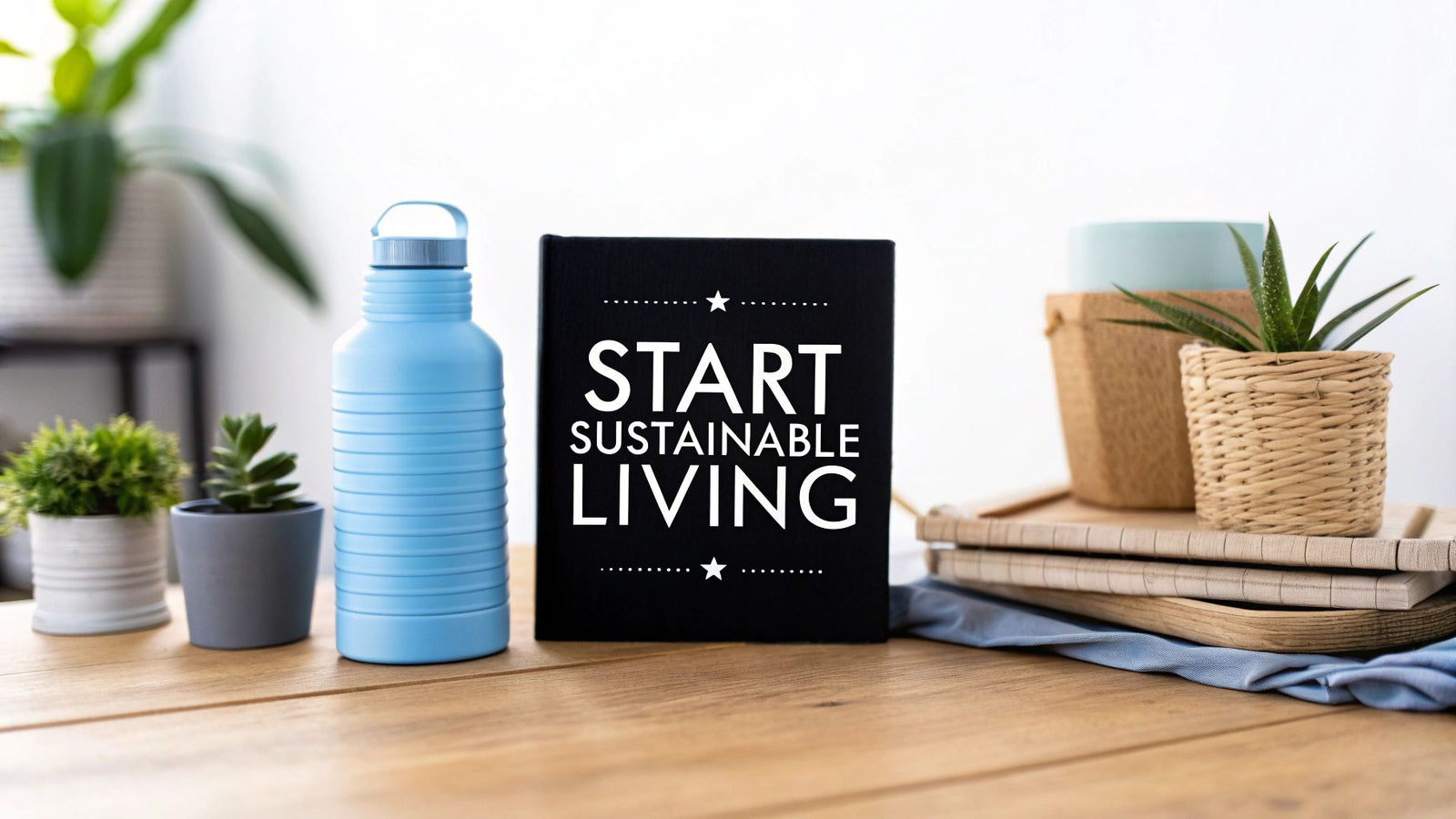
Sustainable living is all about being more aware of how our choices affect the planet. It's not a quest for perfection. It’s about taking thoughtful steps—whether they feel big or small—to make sure the world stays healthy for generations to come. Think of it as managing your own personal 'eco-budget.'
Defining Sustainable Living Without the Buzzwords
Have you ever felt like "sustainable living" is some exclusive club with a long, complicated list of rules? Let's clear the air. At its heart, it’s simply about understanding that our daily actions have a ripple effect on the environment, society, and the economy. It’s choosing to be mindful of those ripples.
Instead of a rigid checklist, think of it as a flexible approach to life. It’s about pausing to ask a few simple questions: "Do I really need this?" "Is there a reusable option?" "Where did this come from, and where will it end up?" Answering these honestly is what guides you toward making more intentional choices.
The Big Picture in Simple Terms
So why do these small choices even matter? It helps to zoom out and look at the global picture. Over the last three decades, global greenhouse gas emissions have skyrocketed by 50%, mostly because of our reliance on fossil fuels. That single stat shows just how urgently we need a change in direction.
This infographic breaks down some of the biggest global impacts our habits have on everything from greenhouse gases to our food systems and forests.
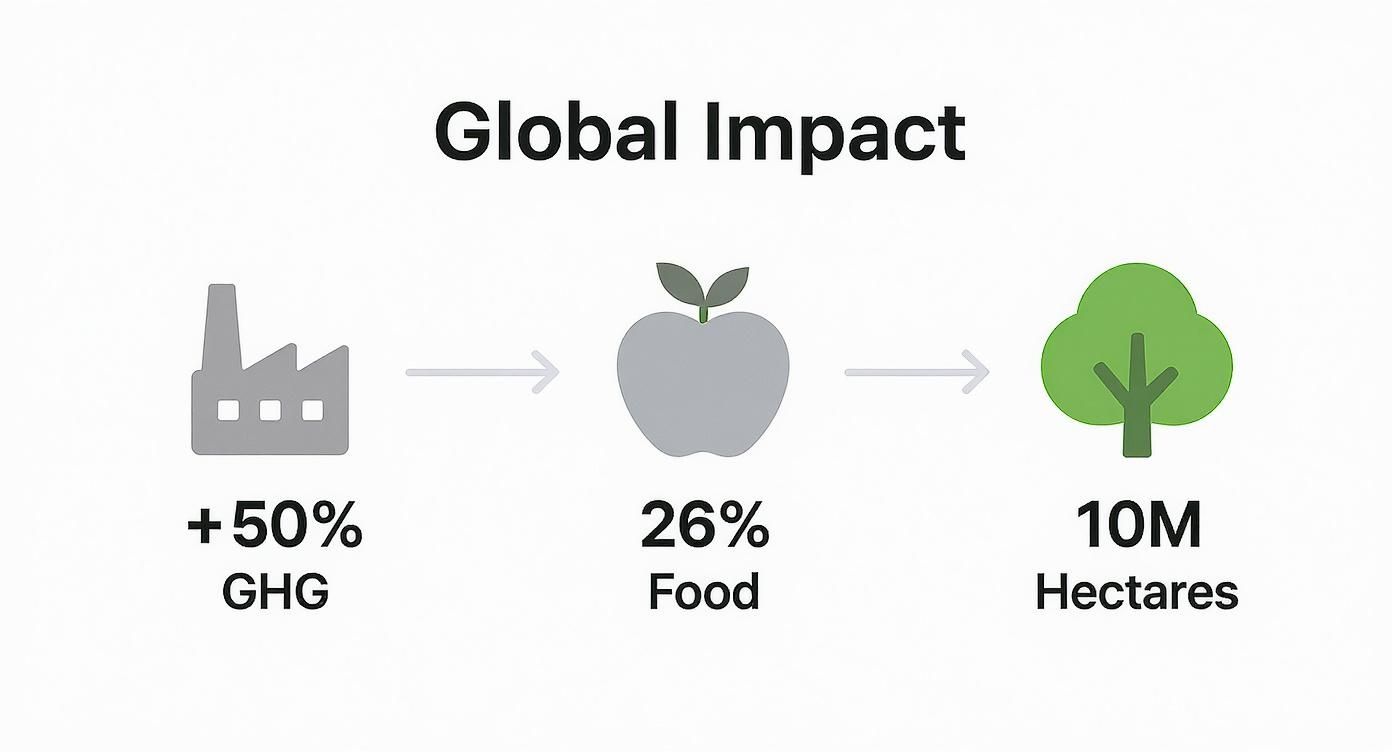
These numbers really connect the dots between our day-to-day lives and the major environmental challenges we're facing as a planet.
From Linear to Circular Thinking
One of the biggest shifts in sustainable living is moving away from a "take-make-waste" mindset. We're used to buying something, using it, and then tossing it. The goal is to move toward a more circular way of thinking. A great way to understand this is to look into circular economy waste management, where the whole idea is to keep resources in use for as long as humanly possible.
This is where durable, reusable products become heroes. Choosing items designed for a long life, like a HYDAWAY collapsible water bottle, is a perfect real-world example. Instead of adding to the mountain of single-use plastic, you have a reliable, space-saving tool that fits perfectly into a waste-reducing lifestyle. It's practical: you can stash it in your bag for your daily commute, take it to the gym, or pack it for a flight without sacrificing space. Part of this mindset is also choosing safer materials, and you can learn more about making smart choices by reading up on what is BPA-free plastic.
To make this easier to digest, here's a simple breakdown of the core pillars that hold up the idea of sustainable living.
The Core Pillars of Sustainable Living
| Pillar | Core Principle | Simple Example |
|---|---|---|
| Reduce | Use fewer resources and create less waste from the start. | Carrying a reusable coffee cup to your local cafe. |
| Reuse | Find new purposes for items instead of throwing them away. | Using glass jars for food storage or as plant pots. |
| Recycle | Properly sort waste so materials can be made into new products. | Separating paper, plastic, and glass for curbside pickup. |
| Conserve | Protect natural resources like water, energy, and ecosystems. | Turning off lights when you leave a room or taking shorter showers. |
| Support Local | Choose local businesses and producers to reduce transportation emissions and support your community. | Buying fresh produce from a local farmer's market. |
These pillars aren't complicated rules; they're just common-sense guides to help you make more mindful decisions every day.
Sustainable living isn’t about depriving yourself. It's about enriching your life by aligning your actions with your values and making smarter, more resourceful choices for a healthier planet.
Ultimately, this is a journey of learning and adapting, not a final destination. Every small, conscious decision you make adds up to a much larger, positive impact.
Why Sustainability Is About More Than Just the Planet
When someone says “sustainable living,” what’s the first thing you picture? For most of us, it’s recycling bins and reusable grocery bags. And while those things are definitely part of the equation, they don't paint the whole picture.
Real sustainability is a balancing act. It's not just about protecting the environment; it’s about creating a system that supports people and makes economic sense at the same time.
Think of it like a three-legged stool. If you chop one leg short, the whole thing topples over. Sustainability is built the same way, resting on three solid legs: environmental, social, and economic. For any choice to be truly sustainable, it has to hold up all three.
The Environmental Pillar: Our Foundation
This is the leg we're all most familiar with. The environmental pillar is all about protecting our natural world—the air we breathe, the water we drink, and the wild places that keep our planet alive. It’s about cutting down on pollution, using resources wisely, and shrinking our carbon footprint.
A practical example is the growing trend of community composting. Neighbors are collecting food scraps to create nutrient-rich soil for local gardens, directly reducing methane emissions from landfills. But you don't need a community program to make a difference. Choosing a durable, reusable product like a HYDAWAY collapsible water bottle has a huge impact. Instead of adding to the 8 million metric tons of plastic that choke our oceans every year, you get a convenient, long-lasting alternative that fits right in your pocket. It’s an easy switch that makes staying hydrated on the go waste-free.
The Social Pillar: Connecting Communities
The social pillar is all about people. It’s about building a world that’s fair, equitable, and healthy for everyone, both in our own neighborhoods and across the globe. This means supporting fair labor practices, empowering communities, and making sure everyone has access to what they need to thrive.
A great current example is supporting brands that are transparent about their supply chains, ensuring workers are paid fairly and treated ethically. When you choose a local coffee shop that sources fair-trade beans and pays its team a living wage, you’re practicing social sustainability. That small purchase helps build a stronger, more connected community right where you live.
True sustainability isn't a choice between people and the planet. It’s about seeing how deeply connected they are. A healthy planet supports healthy communities, and healthy communities are better equipped to protect the planet.
The Economic Pillar: Creating Lasting Value
The third leg of the stool is the economic one. This isn't about chasing endless profits at any cost. It's about building smart, efficient systems that are both profitable and responsible, connecting our personal finances with our bigger goals.
A perfect example is the rise of clothing rental services and thrift shopping. Instead of buying fast fashion for a single event, people are choosing to rent or buy secondhand, saving money while reducing textile waste. This is a move that’s good for your wallet and eases the strain on global resources—a win-win.
The same logic applies to investing in a reusable HYDAWAY bottle. The average American drops over $100 a year on single-use bottled water. By making a one-time purchase, you save money year after year while keeping plastic out of landfills. It's a simple choice where economic and environmental benefits go hand-in-hand.
Once you see these three pillars, it becomes clear what sustainable living is all about. It's a holistic approach where our daily actions can create positive ripples that benefit the planet, strengthen our communities, and even pad our wallets.
Your Everyday Guide to a Sustainable Lifestyle
Okay, so you get the "what" and "why" behind sustainable living. That's the first step. But the real adventure starts with the "how." The secret is turning those big, inspiring ideas into small, everyday habits. That’s where you’ll actually see and feel the difference.
The best way to get started is with a simple framework that I’ve found incredibly helpful: the '5 Rs'—Refuse, Reduce, Reuse, Repurpose, and Recycle.
This isn’t about flipping your life upside down overnight. Far from it. It’s about making a string of small, mindful choices that build on each other. Think of it as your practical toolkit for making this whole sustainable lifestyle thing a reality, one simple action at a time.
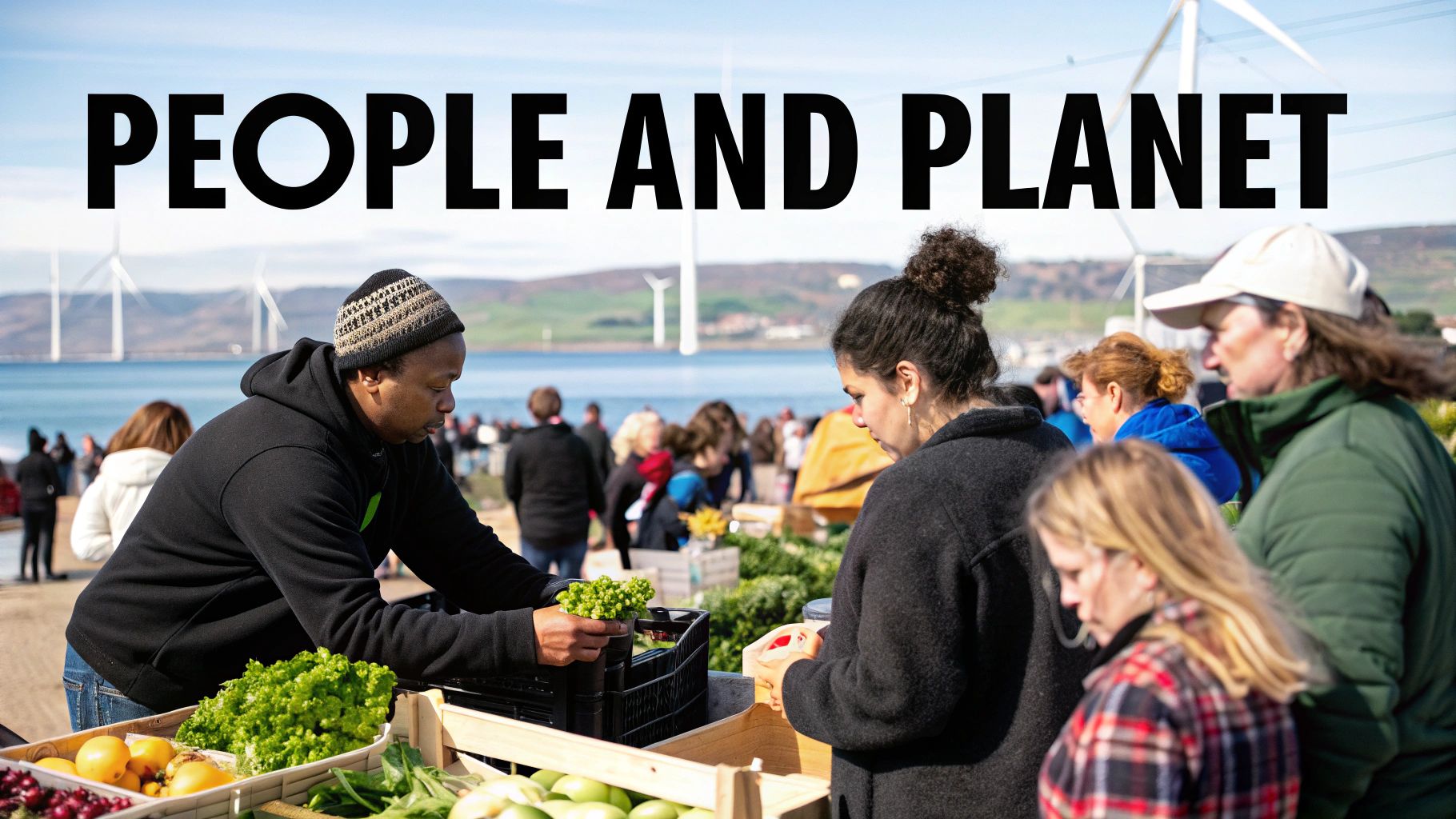
Start with Refuse and Reduce
Honestly, the single most powerful thing you can do is stop waste before it even starts. This is exactly where "Refuse" and "Reduce" come in. They’re the foundation for a more minimalist and intentional way of living.
Refuse is all about flexing your power as a consumer. It’s just saying "no, thank you" to the stuff you don’t need, especially single-use junk. A practical, everyday example is declining the freebie pen at a conference or skipping the plastic produce bag for your bananas at the grocery store.
Reduce is the natural next step. This just means consciously cutting back on what you use—from the food you buy to the energy you consume at home. It might seem small, but since households are responsible for a whopping 72% of greenhouse gas emissions globally, these little changes at home add up to a massive collective win.
Here are a few easy ways to put this into practice:
- Audit Your Mailbox: Use a service like PaperKarma to unsubscribe from junk mail and catalogs you never read.
- Plan Your Meals: Use an app like Mealime to create a weekly meal plan so you only buy the groceries you truly need, cutting down on food waste.
- Check Your Water Usage: Turn off the tap when you brush your teeth and get that leaky faucet fixed. A tiny drip can waste gallons of water every single day.
Embrace the Power of Reuse
Once you're in the groove of refusing and reducing, the next 'R' is all about finding creative ways to use things again and again. Reuse is really the heart and soul of a circular economy—it gives our stuff a longer life and keeps it out of the landfill.
This is where having smart, durable gear makes a world of difference. Think about your morning coffee or staying hydrated on a crazy travel day. Instead of grabbing a throwaway cup or bottle, you can lean on a solid, long-lasting alternative.
The core idea of reuse is simple: invest in quality items that you can depend on for years. This shifts your mindset from temporary convenience to lasting value, saving you money and reducing your environmental footprint simultaneously.
This is exactly the role HYDAWAY's collapsible water bottles and travel gear play. Picture this: you’ve just chugged your water to get through airport security. Instead of hunting for a trash can for a plastic bottle, you just collapse your HYDAWAY bottle, stick it in your pocket, and it’s ready for a refill on the other side. It’s a seamless way to ditch single-use plastics without giving up convenience. The same goes for food on the go; using a collapsible silicone food container for your lunch or leftovers is such a simple swap that makes a huge impact.
Get Creative with Repurpose
Before you toss something, just pause and ask: could this have a second life? Repurpose is all about getting creative and resourceful. It's taking an old item and giving it a brand-new job.
This is where you can have a lot of fun and save some cash. And you definitely don't need to be a DIY expert to make it work.
A few super easy ideas:
- Use old glass pasta jars for storing grains, nuts, or even pens and pencils on your desk.
- Turn that worn-out t-shirt you love into a stack of cleaning rags.
- Plant some herbs in an old coffee mug that has a little chip in it.
A big part of living more sustainably is becoming more self-sufficient. Repurposing is a great first step, and if you're feeling a bit more adventurous, you can take it even further and learn how to start a vegetable garden right in your own backyard.
Recycle the Right Way
Finally, we get to Recycle. While it’s often the first thing people think about, it should really be your last resort after you've tried to refuse, reduce, reuse, and repurpose. Recycling is a big industrial process that uses a ton of energy and resources.
And getting it right is critical. "Wish-cycling"—tossing something in the blue bin hoping it's recyclable—can actually contaminate an entire batch of materials, sending it all to the landfill.
To be a better recycler:
- Check Local Guidelines: Recycling rules are different everywhere. Seriously, they vary from town to town. Hop on your local waste management website to see exactly what they take.
- Clean Your Containers: A quick rinse is all it takes. Leftover food gunk can ruin other materials like paper and cardboard.
- Know the Numbers: Look for the little recycling symbol with a number inside. This tells you the type of plastic, but it doesn't guarantee it’s accepted in your area. Always, always check your local rules first.
Making an Impact with Conscious Consumption
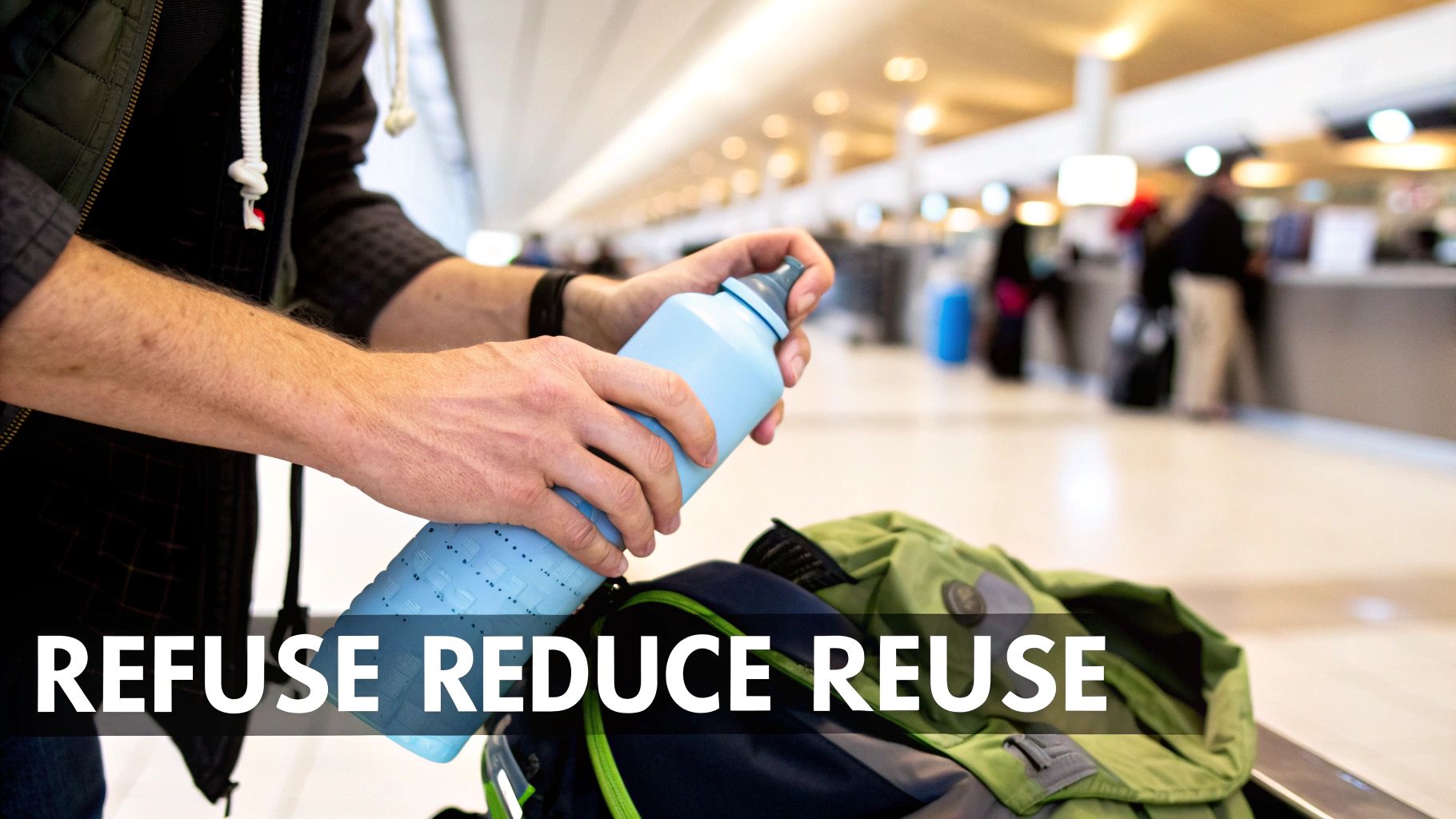
It’s easy to feel like one person can’t make a difference, but that’s just not true. You have the power to shape the world every single day, and you do it with your wallet.
Every purchase you make sends a clear signal to companies about the values you stand for.
How To Spot Truly Sustainable Brands
So, how do you separate the genuinely good guys from the clever marketers? The key is to look for trusted credentials that prove they’re walking the talk.
In a crowded marketplace, these certifications are clear, verifiable signals that a company is committed to more than just its bottom line.
- B Corp Certification means a company meets tough social and environmental standards.
- Fair Trade is all about ethical labor practices and fair prices for producers.
- Forest Stewardship Council (FSC) confirms that paper and wood products come from responsibly managed forests.
- Cradle to Cradle looks at material safety and how a product is designed to be part of a circular system.
But it goes beyond labels. True transparency is about pulling back the curtain on how things are made. Brands that openly share details like factory audits and ingredient sources are the ones earning our trust.
"Choosing brands with real environmental commitments turns every purchase into a pledge for the planet."
Understanding The Circular Economy Through A Simple Analogy
Let’s make this simple. Imagine a coffee sleeve at your favorite cafe that you just borrow, return, and see used again and again.
That endless cycle of use, return, and reuse is the heart of a low-waste circular economy.
- Products are designed for multiple lifecycles, not just one.
- Materials are kept in motion through repair, resale, and repurposing.
- We choose durable goods that can fit back into natural or industrial loops.
Think of it this way: a collapsible HYDAWAY bottle is just like that coffee sleeve. It collapses down after you’re done and pops open for the next refill, completely avoiding waste. It’s a perfect example of a product designed for a circular life, fitting seamlessly into a daily routine where convenience doesn't have to create trash.
Leveraging Your Choices To Drive Change
Believe it or not, consumer behavior is a huge driver of sustainable living trends all over the world.
Studies show that sustainable products are actually outperforming conventional ones in growth by wide margins. You can dig into the numbers in this Time report on sustainable companies.
Every time you buy an eco-friendly product, you’re encouraging more businesses to get on board. When you pick reusable dinnerware, you’re telling companies to invest in long-lasting designs instead of disposables.
Ready to amplify your impact? Here’s how:
- Pinpoint the biggest sources of single-use waste in your daily routine.
- Swap them out for collapsible or reusable gear like HYDAWAY bottles and food containers.
- Support zero-waste stores and brands that publish their environmental reports.
If you’re interested in practical ways to cut down on single-use plastics in your life, check out our guide on How to Reduce Plastic Waste.
By aligning what you buy with what you believe, you become an active participant in this movement. Your choices create ripples that travel through supply chains, sparking real innovation and even policy shifts.
"Every dollar you spend is a vote for the future you want to see."
This is your personal invitation to start casting votes for a circular, sustainable world. Embrace the power you have as a consumer and watch the market respond.
Real-World Case Study Of Conscious Purchases
In 2023, one solo traveler took a two-week trek and replaced over 50 single-use bottles with a single HYDAWAY 25oz bottle.
This one simple switch saved them roughly $200 and stopped about 25 pounds of plastic from ever reaching a landfill. That’s a huge win from one small change.
- Hikers love how the collapsible bottle fits easily into any backpack.
- Office commuters are ditching their daily disposable coffee cups.
- Festival-goers can refill at water stations without lugging around a bulky bottle all day.
This story just goes to show how our everyday choices can add up to create significant environmental benefits. You hold the power to scale these wins, one smart purchase at a time.
The Unexpected Perks of Going Green
Most people think a sustainable lifestyle is about sacrifice, about giving things up. But that's not the whole picture. Not even close. When you start making eco-friendly choices, you kick off a ripple effect that touches every part of your life—your health, your wallet, and even your peace of mind.
Going green often means getting healthier without even trying. Biking to work instead of sitting in traffic? That's a workout built right into your day. Choosing local, seasonal foods means you’re eating things at their absolute peak—fresher, tastier, and packed with more nutrients.
It's More Than Just a Win for the Planet
The personal rewards run deep. For starters, many people find that consuming less and repairing more is a huge financial relief. You'd be amazed at how much money stays in your pocket when you stop buying stuff you don't really need and learn to fix what you already have.
This shift in mindset is also a powerful antidote to what's often called "eco-anxiety." Taking small, concrete actions can cut through that feeling of being overwhelmed by huge global problems. It gives you a real sense of purpose and control, a reminder that what you do actually matters.
Adopting a sustainable lifestyle isn't about sacrifice; it's an investment in a richer, healthier, and more connected life for yourself and your community.
Finding Your People and Your Purpose
Once you start down this path, you’ll find you're not alone. You’ll connect with a whole community of like-minded people at the farmers' market, a local repair cafe, or a community garden. Sharing those values builds some seriously strong social bonds, which is one of the most fulfilling parts of it all.
This lifestyle also makes you more resourceful. Take staying hydrated on the go. Instead of constantly buying single-use plastic, a simple tool like a HYDAWAY collapsible bottle becomes your best friend. It’s a durable, convenient solution that saves you money and cuts down on waste. It’s a small choice, but it reinforces a much bigger commitment to living with intention.
It's amazing how these small, sustainable actions translate directly into real, personal benefits. The table below breaks it down, showing that going green is a win for you just as much as it is for the planet.
Personal Benefits of Sustainable Choices
| Sustainable Action | Health Benefit | Financial Benefit | Well-being Benefit |
|---|---|---|---|
| Biking or Walking | Increased cardiovascular fitness and daily physical activity. | Significant savings on gas, car maintenance, and parking fees. | Reduced stress and a greater connection to your local environment. |
| Eating Local Food | Access to fresher, more nutrient-dense produce without long-haul preservatives. | Supports local farmers and keeps money circulating within your community. | Fosters a deeper appreciation for where your food comes from. |
| Repairing Items | Develops practical skills and reduces exposure to chemicals in new products. | Avoids the cost of buying new items, leading to long-term savings. | A sense of accomplishment and pride in your resourcefulness. |
| Using Reusables | Reduces potential exposure to chemicals found in some single-use plastics. | Eliminates the recurring cost of disposable products like water bottles. | Fosters a feeling of proactive contribution to environmental solutions. |
See? Every choice isn't just about reducing your footprint; it's about enriching your life in ways you might not have expected.
How to Stay Motivated on Your Sustainability Journey
Let's be real: trying to live a perfectly sustainable life can feel totally overwhelming. It’s so easy to get bogged down by "eco-guilt," that nagging feeling you’re never doing enough. But here’s the secret: sustainability isn’t about perfection. It’s about progress.
This journey is a marathon, not a sprint, and the most important thing is finding a pace that feels right for you. Just remember, your small, consistent actions, when multiplied by millions of other people doing the same, create a ripple effect of massive positive change.
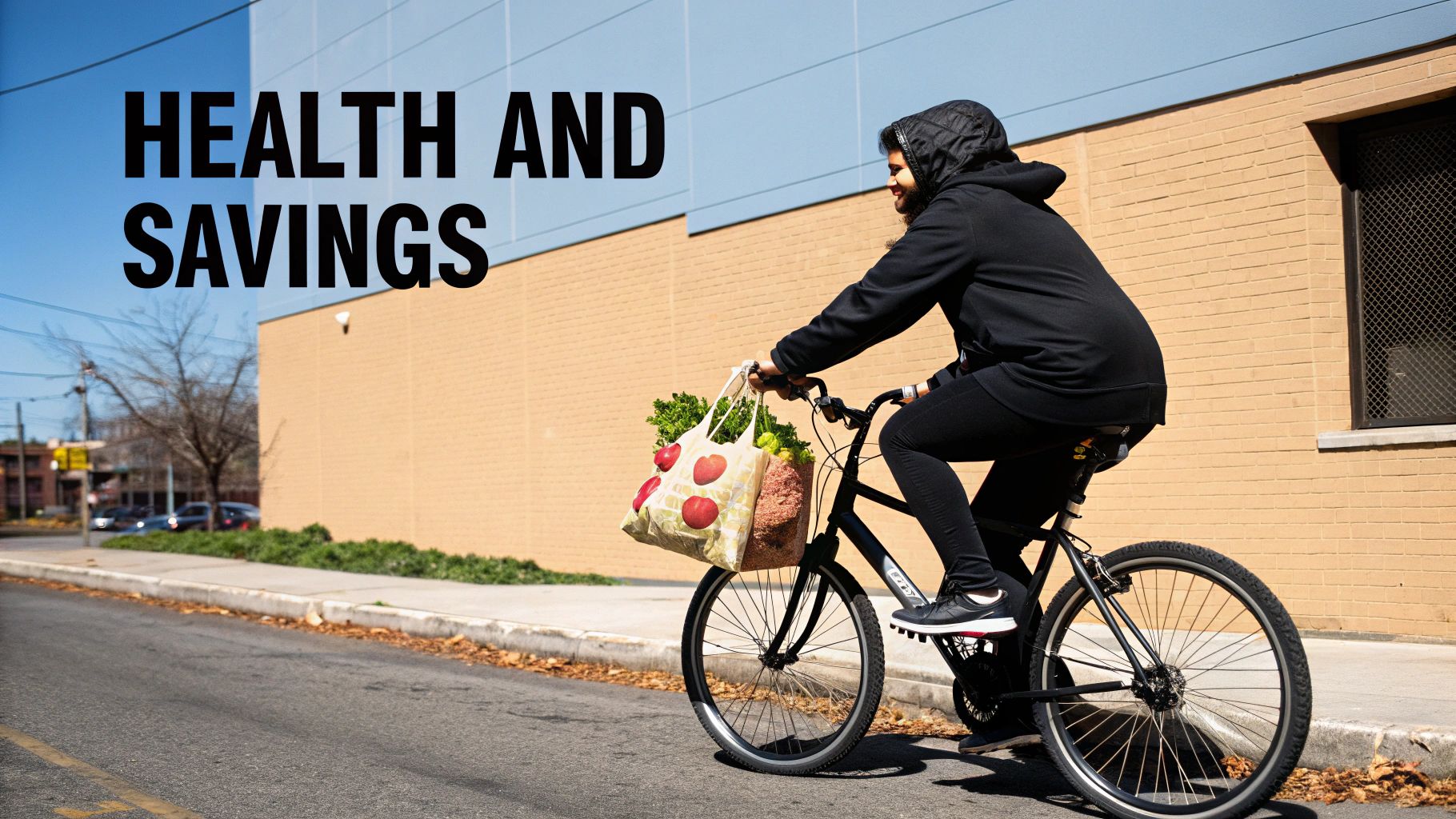
Start Small and Celebrate Your Wins
Trying to change everything all at once is the fastest way to burn out. Instead, pick one small, manageable habit to start with. Maybe it's finally committing to that reusable coffee cup or packing your lunch in a HYDAWAY collapsible bowl a couple of times a week. That single action saves a cup or container from the landfill each time, which is a tangible win.
Once that new habit becomes second nature, celebrate it! Acknowledging your wins, no matter how tiny they seem, gives you the positive reinforcement you need to keep moving forward. It builds momentum and makes tackling the next small change feel that much easier.
The goal is to build a lifestyle, not to achieve a temporary state of perfection. Focus on creating habits that feel natural and rewarding, and you'll find that motivation takes care of itself.
Find Your Community and Stay Inspired
You don’t have to do this alone. Connecting with a like-minded community can make all the difference in the world. Follow some sustainability bloggers who inspire you, join a local environmental group, or maybe even start a "green team" at work. Sharing tips, tricks, and struggles with others helps keep the energy high and holds you accountable.
Inspiration also comes from seeing the big picture. Take a country like Estonia, for example. They’re making incredible strides by combining smart policies with clean energy. By meeting WHO air quality guidelines and prioritizing their forests, they show what’s possible when a whole nation gets on board. Seeing these national sustainability frameworks in action is a powerful reminder that our individual choices are part of a much larger, positive movement.
Make Sustainability Work for Your Budget
One of the biggest myths out there is that living sustainably costs a fortune. Sure, some eco-friendly products have a higher price tag upfront, but so many sustainable habits actually end up saving you money. The real key is to focus on reducing consumption first.
Here are a few budget-friendly tips that still make a huge impact:
- Borrow, don't buy: Need a power tool for a one-off project? Check out a local "Library of Things" or see if a neighbor has one you can borrow.
- Master the art of leftovers: Slashing food waste is one of the most effective things you can do for the planet, and it directly benefits your grocery bill.
- Invest in quality reusables: A one-time purchase of a HYDAWAY bottle means you can stop buying single-use plastic bottles, saving you cash in the long run.
Ultimately, staying motivated is all about finding the joy in the process. Embrace the creativity of repurposing things, the deep satisfaction of a home-cooked meal, and the powerful connection you build with your community along the way.
Common Questions About Sustainable Living
As you start exploring what sustainable living looks like for you, some questions almost always surface. Getting straight, practical answers can make the whole journey feel a lot more doable and way less intimidating. Let's tackle a few of the big ones head-on.
Is Living Sustainably Expensive?
This is probably the most persistent myth out there. The truth? A sustainable lifestyle often saves you a ton of money in the long run.
Sure, some eco-friendly products might have a higher price tag upfront, but the real heart of sustainability is inherently budget-friendly: consume less, reuse more, and waste nothing.
Think about it this way: planning your meals to avoid food waste directly shrinks your grocery bill. Hitting up secondhand stores for clothes or furniture saves a small fortune compared to buying new. Even tiny habits, like brewing coffee at home instead of grabbing a daily takeout cup, add up to serious savings.
The key is to shift your mindset from short-term costs to long-term value. An investment in a durable, reusable item like a HYDAWAY collapsible water bottle means you can stop buying single-use plastic bottles, potentially saving you hundreds of dollars over time.
What Is the Single Most Impactful Change?
That's a fantastic question, but the answer is totally different for everyone. It really depends on your current habits and lifestyle—there's no magic one-size-fits-all solution.
Honestly, the most impactful change is the one you can actually stick with.
For one person, the biggest win might be cutting down on food waste, especially since food production is linked to about 26% of global greenhouse gas emissions. For someone else, it could be saying no to fast fashion or choosing to bike or walk on short errands instead of driving.
A great place to start is to look at the "big three" areas where we consume the most:
- Food: Can you eat a little less meat or get creative with leftovers?
- Transportation: Is it possible to combine errands or take public transit more often?
- Household: Where can you dial back your energy or water usage?
Just pick one area that feels manageable and focus on making a real, consistent change there.
How Can I Stay Sustainable While Traveling?
Trying to stick to your sustainable values on the road can feel like a challenge, but with a little prep, it's easier than you think. Travel is where smart, reusable gear really gets to shine.
The easiest win is simply refusing single-use plastics. This is where products from HYDAWAY become your best travel buddies. A collapsible bottle or bowl takes up almost no room in your bag but lets you refill and reuse over and over, whether you're at an airport water fountain or a cafe in a new city. This is a practical way to avoid buying expensive bottled water and creating unnecessary waste.
Beyond gear, you can pack light to lower your flight's carbon footprint, look for hotels with green certifications, and support local economies by eating at small, family-run restaurants. Every little choice helps you stay true to your goals, no matter where your adventures take you.
Ready to make sustainable travel and everyday life simpler? Explore the full range of collapsible, space-saving gear from HYDAWAY and find the perfect reusable solution for your lifestyle.



